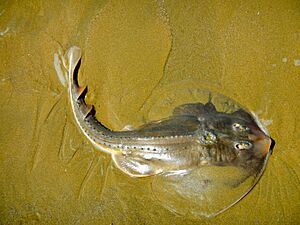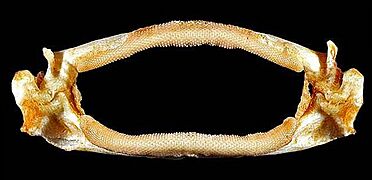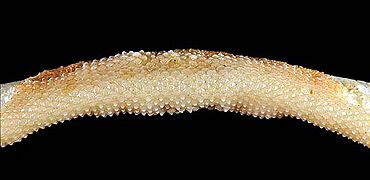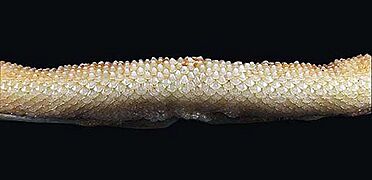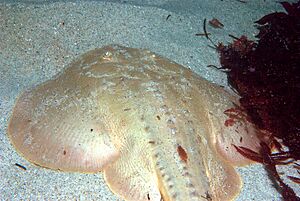Thornback guitarfish facts for kids
Quick facts for kids Thornback guitarfish |
|
|---|---|
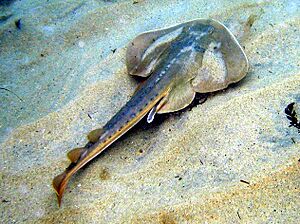 |
|
| Conservation status | |
| Scientific classification | |
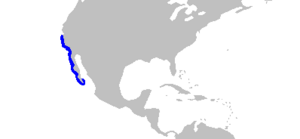 |
|
| Range of the thornback guitarfish | |
| Synonyms | |
|
Platyrhina triseriata D. S. Jordan & Gilbert, 1880 |
The thornback guitarfish (Platyrhinoidis triseriata) is a type of ray. It belongs to the family Platyrhinidae. This ray is the only member of its genus. Even though it looks like a guitarfish, it is actually more closely related to electric rays.
You can find this species from Tomales Bay to the Gulf of California. They usually live in shallow waters, about 20 feet deep or less. They often hide in sand or mud. You might also spot them near kelp beds. These rays can grow up to 3 feet long. They have a heart-shaped body and a long, strong tail. Their tail has two fins on top and a well-developed tail fin. The most special thing about them is the three rows of large, hooked thorns. These thorns run from the middle of their back all the way to their tail.
Thornback guitarfish can be found alone or in groups. They eat small creatures that live on the ocean floor. These include invertebrates and small bony fishes. Female thornback guitarfish give birth to live young. The babies grow inside the mother, getting food from a yolk sac. Females usually have 1 to 15 pups each year in late summer. Their pregnancy lasts about one year. The International Union for Conservation of Nature (IUCN) says this ray is of Least Concern. This is because most of them live in United States waters. They are common there and not often caught by fishers. Their numbers in Mexican waters are not as well known.
Contents
How it Got its Name and Family Tree
American ichthyologists David Starr Jordan and Charles Henry Gilbert first described the thornback guitarfish. They wrote about it in 1880. They named it triseriata from Latin words meaning "three" and "row." This name refers to the three rows of thorns on its back.
A year later, Samuel Garman put this species in a new group called Platyrhinoidis. Other common names for this ray include banjo shark and California thornback. Scientists study how different fish are related. Some studies looked at their body shapes. Other studies looked at their DNA. These studies help us understand their "family tree."
What Does it Look Like?
The thornback guitarfish has a heart-shaped body. It is a bit longer than it is wide. Its snout is short and wide, with a blunt tip. Its eyes are small and far apart. Behind the eyes are larger openings called spiracles. These help the ray breathe.
Its mouth is wide and curved. It has many small teeth, about 68 to 82 rows in the upper jaw. The lower jaw has 64 to 78 rows. It has five pairs of small gill slits under its body.
The tail is strong and much longer than the body. It has skin folds on the sides. The two fins on its back are similar in size. The first back fin is closer to the tail fin. The tail fin is well-developed and almost oval. Its skin is covered in tiny, rough scales. It also has large, curved thorns. These thorns are on the front edge of its body, around its eyes, and on its "shoulders." Most notably, there are three rows of thorns running down its back to the second dorsal fin. This ray is usually olive to grayish-brown on top. Its underside is off-white. It can grow up to 3 feet long.
Where Does it Live?
The thornback guitarfish lives only in the northeastern Pacific Ocean. You can find it from Tomales Bay in California to Magdalena Bay in Mexico. There are also some groups in the Gulf of California. It is very common in some coastal waters off California and Baja California. However, it is less common north of Monterey.
This ray lives on the ocean bottom. It usually stays close to shore in waters less than 20 feet deep. But it has been seen as deep as 450 feet. It likes coastal areas with muddy or sandy bottoms. This includes bays, sloughs, beaches, and lagoons. It can also be found in kelp beds.
Life and Habits
During the day, the thornback guitarfish often buries itself partly in the sand. You might see them alone, in small groups, or in large gatherings. These large groups form at certain times of the year in bays.
This ray eats many different things. Its diet includes polychaete worms, crustaceans like crabs and shrimps, and squids. It also eats small bony fishes such as anchovies and sardines. It can find its prey using special sensors. These sensors detect electric fields in the water.
Sharks and the northern elephant seal (Mirounga angustirostris) sometimes eat thornback guitarfish. This ray can also have parasites. These include a type of tapeworm and a nematode.
Reproduction and Life Cycle
Thornback guitarfish mate in late summer. Females give birth the next year, around the same time. The peak birth month is August. They are aplacental viviparous. This means the babies grow inside the mother. They get all their food from a yolk sac until they are born.
Females have litters of 1 to 15 pups every year. Newborn rays are about 4 inches long. Males become ready to reproduce when they are about 15 inches long. Females are ready when they are about 19 inches long.
Thornback Guitarfish and Humans
The thornback guitarfish is harmless and calm. You can easily get close to it underwater. They also do well in public aquariums. Off the United States, this ray is common. It does not face many big threats. Fishers only catch it by accident sometimes. It is not valuable for commercial fishing.
Because most of them live in US waters, the International Union for Conservation of Nature (IUCN) lists them as Least Concern. This means they are not in danger of disappearing. However, in Mexican waters, the population is smaller. It is not clear how much fishing affects them there. More information is needed to make sure they survive in that region.



